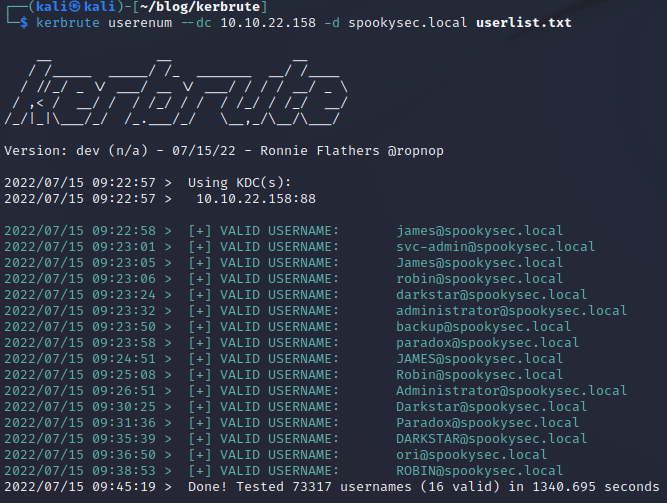kerbrute
- Thiru T
- Jul 18
- 3 min read

Kerbrute is an open-source command-line tool made for attacking Active Directory (AD) domains with the Kerberos protocol. Red teams, which are ethical hackers simulating attacks, and malicious actors often use it.
Here’s a summary of what Kerbrute does and why it's important:
How Kerbrute Works
Kerbrute mainly takes advantage of the Kerberos pre-authentication feature. Kerberos is an authentication protocol that uses "tickets" to verify user identities. Normally, a user must confirm their identity, such as by providing a password, before receiving a ticket-granting ticket (TGT).
Kerbrute exploits the way the Kerberos service, known as the Key Distribution Center (KDC), responds to pre-authentication failures. If a username exists and the pre-authentication fails because of an incorrect password, the KDC often sends a specific error message. Kerbrute interprets this error to check if a username is valid, even without the correct password.
Key Capabilities of Kerbrute
User Enumeration: One of its main functions is to quickly and discreetly list valid usernames in an Active Directory domain. This is especially helpful when attacking from a machine not part of the domain, as finding valid usernames can be difficult in that case.
Password Spraying: After identifying valid usernames, Kerbrute can perform password spraying attacks. This means trying a few common passwords against a large list of usernames. This method often avoids account lockout policies that might trigger traditional brute-force attacks, where many passwords are tested against a single username.
Brute-Force Attacks: Although less common due to lockout policies, Kerbrute can also be used for standard brute-force attacks on individual accounts.
Why Kerbrute is a Concern for Defenders
Stealthy Reconnaissance: Because it mainly uses Kerberos error messages and does not create typical failed logon events, such as Event ID 4625 for NTLM-based attacks, Kerbrute can be hard for many traditional security monitoring systems to spot.
Bypassing Lockout Policies: Its password spraying ability can help attackers avoid account lockout mechanisms. This allows them to try many credentials without locking accounts.
Precursor to Further Attacks: Finding valid accounts is often the first step in more complicated attacks, like credential stuffing, pass-the-ticket, or Kerberoasting.
Detection and Mitigation
Detecting Kerbrute activity often requires:
Monitoring Kerberos Logs: Check for specific Kerberos error codes that show pre-authentication failures, like Event ID 4768 or 4771, in addition to a high volume of requests from a single source.
Command Line Auditing: Turning on command line auditing on endpoints can help catch the use of "kerbrute" in process creation events.
Sysmon: Using and setting up Sysmon to capture process creation and termination events, as well as network connections.
Behavioral Analytics: Security Information and Event Management (SIEM) systems with behavioral analytics can detect suspicious patterns that may indicate Kerbrute activity, even if direct command-line evidence is missing.
Mitigating the risks involves:
Strong Password Policies: Implementing complex and unique passwords makes password spraying less effective.
Multi-Factor Authentication (MFA): Adding MFA greatly reduces the risk of successful attacks, even if credentials are leaked.
Account Lockout Policies: Although Kerbrute aims to circumvent them, well-configured lockout policies can still deter some attacks.
Network Segmentation: Limiting access to domain controllers and critical systems helps improve security.
Regular Security Audits and Penetration Testing: Testing your defenses against tools like Kerbrute can help reveal vulnerabilities.
In short, Kerbrute is a powerful tool for testing or exploiting weaknesses in Active Directory related to Kerberos authentication. Understanding how it works is key for strong cybersecurity defense.
Install: (Go)
go get github.com/ropnop/kerbruteInstall: (Make)
git clone https://github.com/ropnop/kerbrute
cd kerbrute
make allUsage:
# User Enumeration
./kerbrute_linux_amd64 userenum -d lab.ropnop.com usernames.txt
# Password Spray
./kerbrute_linux_amd64 passwordspray -d lab.ropnop.com domain_users.txt Password123
# Brute User
./kerbrute_linux_amd64 bruteuser -d lab.ropnop.com passwords.lst thoffman
# Brute Force
./kerbrute -d lab.ropnop.com bruteforce -


Comments